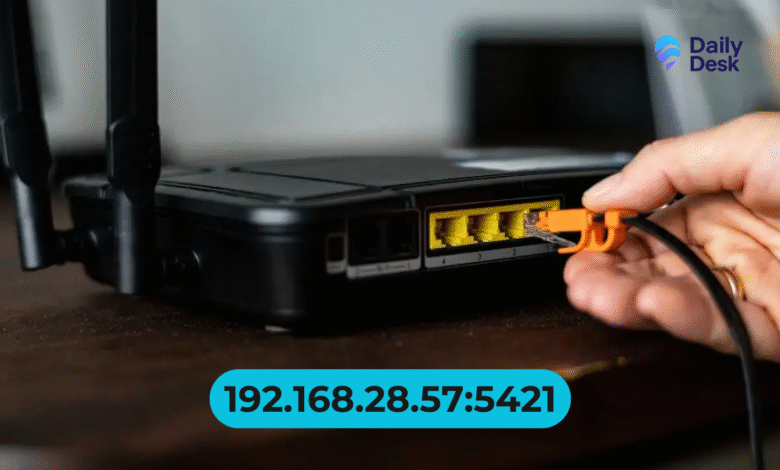A Practical, 192.168.28.57:5421 Human Guide to a Local Service That Works

I first saw 192.168.28.57:5421 on a sleepy Tuesday, a small address glowing in a browser bar. It looked ordinary. A number with a colon. But the moment the page loaded, the room felt organized. Like a switch clicked.
You might have your own reason to reach 192.168.28.57:5421 today. Maybe a dev server. Maybe a camera stream. Or a tiny dashboard that keeps your day honest. Whatever it is, the story starts here.
What You’re Looking At, In Plain Words
It’s a private IP with a specific port. When you visit 192.168.28.57:5421, you’re pointing straight at a single service living on a device in your local network. Nothing mystical. Just focused.
Private ranges don’t cross the public internet without help. So the address stays home. Feels safe. Feels sensible.
Private vs Public, And Why It Matters
A quick reminder: 192.168.x.x is private space. So 192.168.28.57:5421 is reachable only from inside your LAN or through a tunnel you control. That’s by design. It limits exposure.
Want internet reach? You’ll need NAT, a reverse proxy, maybe a VPN. Better yet, don’t open it unless you must. Security breathes easier.
Common Use Cases That Make Sense
Maybe your build server sits quietly behind 192.168.28.57:5421, serving logs and green checks. Or it’s a media node pushing local streams to the lounge TV. Could be a home-automation hub, neat and tidy.
SMBs use it for admin panels. Labs run it for telemetry. Gamers slap a stats board there. Lightweight. Fast. Familiar.
Accessing It Cleanly, Step by Step
First, confirm you’re on the same subnet. Then open a browser and type 192.168.28.57:5421 straight in the address bar. Don’t add http unless required by the app. Some services redirect. Some don’t.
If it times out, ping the IP. If ping responds, test the port with curl or PowerShell. You’re narrowing the problem. Calmly.
Easy Setup and Troubleshooting Tips
Write the device name and map it to 192.168.28.57:5421 in your hosts file for simple recall. Small habit. Big ease. Keep a bookmark too.
If your browser refuses, try another client. CLI first. GUI later. And reboot less; collect clues more. It saves time.
Also check cables, DHCP leases, static IP conflicts, and your gateway. Small things bite. Fix them once; label stuff; be kind to Future You.
Routers, NAT, and the Temptation to Expose
Think twice before forwarding 192.168.28.57:5421 to the internet. Forwarding equals risk. Attackers scan. Bots don’t sleep. Caution wins.
If you must, consider reverse proxy with auth, rate-limits, and TLS. Or build a VPN and keep access private. Simple, safer.
Firewalls: The Quiet Gatekeepers
Host and network firewalls both matter. Allow inbound TCP to the process that listens on 5421, but only from trusted subnets. Keep rules tight.
If a rule blocks 192.168.28.57:5421, logs will tell you. Read them. They’re boring until they’re not. Then they’re gold.
The Service Behind the Port
Ports are doors; services are rooms. If 192.168.28.57:5421 runs a custom app, confirm it binds to the right interface. 0.0.0.0 for all, 127.0.0.1 for local only.
Env files drift. Reboots reset things. A single mistyped value can hide a whole server. Double-check. Then breathe.
Connectivity Tests, The Smart Basics
You can’t ping a port, only an IP. So ping 192.168.28.57 first. Then test the service with curl 192.168.28.57:5421 or Test-NetConnection in PowerShell. Different tools, different truths.
Traceroute won’t help much inside a flat LAN. But ARP tables will. Learn them, a little. Enough to see ghosts.
Static Leases and Local Names
Reserve the IP in DHCP. Make 192.168.28.57:5421 predictable. Nothing wrecks a morning like a changed address with no note left behind.
If you run local DNS, add a record. service.home points to 192.168.28.57, and your app listens on 5421. Clean. Memorable.
Security Hardening That Doesn’t Hurt
Add TLS, even on LAN. A self-signed or local CA cert is fine. Better than nothing. Much better. Put a password behind 192.168.28.57:5421. No anonymous guests.
Segment networks. Admin VLAN here, media VLAN there. If a toaster gets weird, it won’t reach the important stuff. Sleep better.
Logging and Monitoring That Actually Helps
Enable access logs for 192.168.28.57:5421 and rotate them. Light on the eyes. Heavy on the facts. Tag entries with device names so the story reads well.
Set simple alerts. Up/down checks. Port reachability. CPU spikes. Nothing fancy. Signal over noise.
Performance Tweaks When Things Feel Slow
Measure first. Latency to 192.168.28.57:5421, CPU on the host, disk IO, memory pressure. Only then tune. Guessing is expensive.
Cache static assets. Compress responses. Trim chatty logs. A few toggles, and the service breathes easier. Users do too.
Containers, Dev Environments, and Ports
In Docker, bind the container’s internal port to the host with -p 5421:5421. Then map your LAN to 192.168.28.57:5421 as usual. Short path. Clear map.
Compose files help. Version them. Comment them. Future You will send a small thank-you later.
Remote Workflows with VPN
A VPN keeps 192.168.28.57:5421 private but reachable from afar. WireGuard is simple. OpenVPN is sturdy. Pick your style.
Route only what you need. Split-tunnel smartly. Latency might rise, a hair, but safety rises more. Fair trade.
Backups and Little Disasters
If this address hosts config or content, back it. Snapshots daily, off-box weekly, off-site monthly. Old rule. Still good.
Restore tests matter more than backup success. Can you rebuild 192.168.28.57:5421 in an hour? Practice once. Write the steps. Done.
Compliance, Audits, and Quiet Proof
Document who can touch 192.168.28.57:5421 and why. Least privilege. Short lists. Stale access kills audits and trust.
Keep a change log. Tiny notes are enough. Dates, reasons, and what broke (or didn’t). You’ll thank yourself on the bad day.
A Small Story, Because Tech Is Human
We moved an internal dashboard to 192.168.28.57:5421 after a long week. Friday. Rainy. Coffee cold. The page loaded fast and clean.
The team exhaled. Nobody cheered. Didn’t need it. The service just worked. Honestly, that’s all we wanted.
Mistakes People Make (And Easy Fixes)
- Exposing 192.168.28.57:5421 to the internet without auth. Don’t do that. Use VPN or reverse proxy.
- Forgetting static DHCP. Address drifts, bookmarks die. Reserve it.
- Assuming ping equals app health. It doesn’t. Test the port.
- Skipping TLS on LAN. Add it. Yes, even here.
Small habits save big mornings. Build them slow. Keep them.
Quick-Start Checklist You Can Print
- Confirm the host answers at 192.168.28.57:5421 on your LAN.
- Reserve DHCP, set local DNS, and bookmark the URL.
- Add TLS, enable auth, and restrict firewall rules.
- Log access, set a simple uptime check, and schedule backups.
Review quarterly. Takes ten minutes. Pays for itself.
FAQ: Easy Setup and Troubleshooting Tips
- What is 192.168.28.57:5421 exactly?
A private IP plus a port, pointing to a single service on your local network. Think “room number” on a known street. - Why can’t I reach it from outside my home?
Private ranges aren’t routed on the public internet. Use a VPN or a secure reverse proxy if remote access is essential. - It pings, but the page won’t load. Now what?
Ping checks the host, not the service. Test the port with curl http://192.168.28.57:5421 or PowerShell Test-NetConnection -ComputerName 192.168.28.57 -Port 5421. - Do I need HTTPS on my LAN?
Strong yes. Self-signed or local CA is fine. Encrypt anyway. Credentials deserve respect. - How do I make the address “stick”?
Create a DHCP reservation and, if possible, a local DNS record. Predictability beats panic. - Is port forwarding safe?
Not by default. If you must, place a reverse proxy in front with auth, rate limiting, and TLS. Logs too. - Which firewall rules should I set?
Allow inbound TCP 5421 only from trusted subnets. Block WAN by default. Log drops to learn without guessing. - Can I change the port?
Sure. Update the service config, firewall, and any bookmarks. Re-test end to end. Don’t half-move it. - My browser complains about certificates. Help?
Install your local CA or trust the cert per device. Or use a proper cert via internal ACME if your environment supports it. - Any quick diagnostics?
- Ping the IP. 2) Test the port. 3) Check service status. 4) Read logs. 5) Disable, then re-enable firewall with a known-good profile. One step at a time.
Governance and Ownership, Even at Home
Decide who owns 192.168.28.57:5421. One person, one team. Ownership avoids the “who touched it” dance when stuff blips.
Write a tiny runbook. Two pages. Location, restart commands, support hours. Good enough.
Capacity Planning Without Drama
Watch memory, storage, and connection counts. If 192.168.28.57:5421 supports many users, add a small cache. A CDN is overkill; LAN is fast already.
Scale vertical first. Then consider splitting services. Keep it boring. Boring scales.
Zero-Trust, But Friendly
Treat 192.168.28.57:5421 like any production app. Verify identity, authorize minimally, log clearly. “It’s just internal” is famous last words.
Rotate keys. Expire sessions. Nudge people to good habits with gentle defaults.
Documentation That People Actually Read
Screenshots. Short steps. A diagram with arrows. Put 192.168.28.57:5421 in a bold box so eyes land fast.
Host docs near the tool. Link from the dashboard footer. People click what’s in front of them.
Observability On a Diet
Expose a /health endpoint. Light checks. Green or red. No drama. If red, link to logs and restart buttons behind auth.
Alert once, not ten times. Fatigue is a bug. Fix it early.
When You Need to Move It
Migrations happen. Clone the service to a new host, say 192.168.28.88:5421, and test quietly. Then swap DNS. Keep the old box warm for an hour.
Have a rollback. Even if you never use it. Your hands shake less.
User Experience, Tiny Touches
Fast first paint. Clear headings. A friendly 404. If 192.168.28.57:5421 is admin-only, say so up front. No guesswork.
Mobile view matters. People check dashboards from couches and kitchens. Make it fit.
Access Control That Doesn’t Annoy
SSO if you have it. If not, unique accounts and short-lived API tokens. Read-only roles for most. Write roles for few.
Log the who and when. Not to spy. To understand.
Maintenance Windows Without Drama
Pick a quiet hour. Post a banner on 192.168.28.57:5421 a day early. “Down for 15 minutes at 10pm.” Keep your promise like a pro.
Afterward, notes in the change log. What changed. What improved. What’s next.
Edge Cases That Sneak In
mDNS can shadow DNS. Hosts files can lie. VPN split-tunnels sometimes skip 192.168.28.57:5421 by mistake. You’ll learn to spot the pattern.
Fix the root cause, not just the symptom. Then write it down. Institutional memory beats heroics.
Training the Team, Light and Useful
Run a 20-minute walk-through. Show where 192.168.28.57:5421 lives, how to check health, who to ping. Then a tiny quiz. Fun, not stiff.
Confidence beats speed. Speed follows confidence anyway.
Change, But Carefully
Batch small fixes. Release often. If 192.168.28.57:5421 is core to your day, no giant bombs. Little ships, steady course.
Feature flags, if you can. Quiet rollouts are kindness.
Decommissioning, The Polite Goodbye
When it’s time, post a banner, move traffic, and archive data. Turn 192.168.28.57:5421 off only when no one calls it. Two weeks of logs confirm silence.
Thank the service in your notes. Sounds silly. Helps closure.
Wrapping It All Up
A private IP. One neat port. Useful as a habit. 192.168.28.57:5421 can be the quiet backbone of your small network, or the heartbeat of your team’s day.
Keep it simple. Keep it safe. Write things down. And let the service do what the best tools do: disappear into the flow and just work.
Read Also: The Timeless Story of the Ekaterinoslavskiy Kirasirskiy Polk





